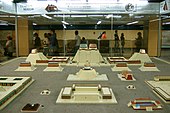Zócalo
[4] The modern plaza of Mexico City was placed by Alonso Garcia Bravo shortly after the invasion when he laid out what is now the historic center.After a mob burned the Viceregal Palace in 1692, depicted in the famous 1696 painting by Cristóbal de Villalpando, authorities attempted to completely clear the plaza to make way for more permanent market facilities, the "Parián de Manila" (or simply "Parián" or the "Alcaicería"), named after the silk trading district of Manila in the Spanish Philippines.This was opened in 1703 and earned a substantial income for the city council from shop rent,[12] as well as turning the plaza into an "an emporium of commerce"[13] and the "center of Mexico's richest trade,"[11] as characterized by contemporary accounts.He claimed it was very difficult to walk around here at the time because of its uneven pavement, mud in the rainy season, aggressive street dogs, mounds of trash and human excrement tossed among the corn husks and other discarded wrappings.[4] This was the backdrop when Viceroy Don Felix Maria Calleja, other authorities and assembled people swore allegiance to the Constitution of Cadiz, and fealty to the Spanish Crown on 22 May 1813 as the Mexican War of Independence raged.A garden with footpaths was created; fountains were placed at each corner; 72 iron benches were installed and the area was lighted by hydrogen gas lamps.[4] From the latter half of the nineteenth century to the beginning of the twentieth, the Zócalo again filled with market stalls, including the "Centro Mercantil" which sold fabric, clothing, and Art Nouveau stonework.[4] During the Decena Trágica (the ten days from 9 to 19 February 1913), the National Palace was bombarded from the nearby military fort, incidentally damaging the Zócalo.[4] As the end of the twentieth century neared, the Zócalo, along with most of the city center (called the Colonia Centro) was in massive disrepair.This is because the original site of the Angel is located in a financial area, with a high traffic flow, making policing more difficult than the Zócalo.Thousands rallied here in protest when Cuauhtémoc Cárdenas lost against Carlos Salinas in a presidential election widely believed to have been rigged in 1988.[27] In 2001, followers of Zapatista leader Subcomandante Marcos, mostly poor Chiapan indigenous people, marched into the Zócalo to support a bill that would give them greater political autonomy.[28] Following Cárdenas' lead, Andrés Manuel López Obrador staged major protests here after the 2006 Mexican presidential elections[29] as well as a rally with thousands of participants against President Calderón's initiative to allow private and foreign investment in Mexico's state-owned energy company, PEMEX.Just before 11 pm on each 15 September, the president of Mexico comes out onto the central balcony of the National Palace to perform the Grito de Dolores to the crowd gathered in the plaza.[32] Under the unpopular rule of Enrique Peña Nieto, the ceremony has been subjected to widespread criticism —mostly from left-leaning sources— for the government's notorious use of acarreados (people who are literally carried into the square by bus and paid for with food or other minor goods) in order to boost attendance numbers and simulate popular enthusiasm.They choose to do the ceremony here not only because it is close to where such rites used to be performed before the Spaniards came, but also because they are right next to the symbols of "Spanish" ecclesiastical and secular power (the cathedral and National Palace, respectively), which they oppose.[34] The Zócalo area has been, since 2014, where large rallies have been held in the aftermath of the 2014 Iguala mass kidnapping, an event that has become symbolic for the climate of widespread criminality, impunity and governmental corruption that many feel the country faces.There are daily impromptu shows of Aztec dancers dancing to drums, wearing feathered headdresses and anklets made of concha shells.The Festival de México is an annual event with programs dedicated to art (popular and fine) and academia held in the Zócalo and some other venues in the historic center.[43] Justin Bieber also offered a free show on 11 July 2012, where he performed in front of 210,000 people as part of the tour for his 2012 album Believe.[44] On 1 October 2016, Roger Waters performed in the square before 170,000 people, once again for free and with a strong political message against Donald Trump and Enrique Peña Nieto included in sections of the show, which consisted of outtakes from his Pink Floyd years.[46] Dutch trance music producer Armin Van Buuren has a song called "Zocalo" on his 2005 album Shivers, which, Josh Gabriel, of Gabriel & Dresden, recounts is named after Zocalo Coffeehouse in San Leandro, California, which Armin visited while recording the song, and which is itself named after the Zócalo in Mexico City.







Zócalo/Tenochtitlan metro stationConstitution Square (disambiguation)Zócalo (Puebla City)Plaza de la ConcordiaMexico Citymain squarecolonial periodTenochtitlanMexican constitutionsCádiz ConstitutionindependenceplinthOaxacaMéridaGuadalajaraMexicanviceroysHoly WeekCorpus ChristiMexico City Metropolitan CathedralNational PalaceFederal District buildingsOld Portal de MercaderesNacional Monte de PiedadTemplo MayorMexican flagPortal de MercaderesPalacio NacionalHistory of Mexico CityMexico City MetroZócalo/TenochtitlanMoctezuma IIAxayacatlAhuitzotlteocalliTepeyacIztapalapaTlacopanjoustinglancesHernán Cortésinvasionhistoric centerPortales de MercaderesAyuntamientodesagüeCristóbal de VillalpandoCorsham CourtPariánsilk trading districtManilaSpanish PhilippinesManila galleonsCharles IV of SpainJuan Vicente Güemes PachecoAztec CalendarCoatlicueMuseum of AnthropologyRoyal and Pontifical UniversitySupreme Courtequestrian statue of Charles IVManuel TolsábalustradeFelix Maria CallejaMexican War of IndependenceNeoclassicalNational Art MuseumAlameda CentralSanta Annaash treescandelabrasBois de BoulogneasphaltArt NouveauDecena Trágicaauthoritarian measuresGustavo Díaz Ordazmarathon1968 Summer OlympicsThe EconomistCuauhtémoc CárdenasMarcelo EbrardAngel de la IndependenciaDay of the DeadSpectreCarlos SalinasZapatistaSubcomandante MarcosChiapanAndrés Manuel López Obrador2006 Mexican presidential electionsPresident Calderón1968 protestspresident of MexicoGrito de DoloresVicente FoxDolores HidalgoGuanajuatoAlejandro EncinasEnrique Peña Nietospring equinoxLa Raza2014 Iguala mass kidnappingconchaSpencer TunickBarcelonaGregory ColbertAshes and SnowNomadic MuseumMexico City Alebrije ParadeCafé TacubaColombianShakiraskateboardingPaul McCartneyOn the Run TourJustin BieberBelieveRoger WatersDonald TrumpPink Floydsci-fiBabylon 5the stationtrance musicArmin Van Buuren